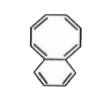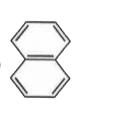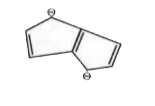Which of the following bonds is most polar ?
Cl−Cl
N−F
C−F
O−F
The correct Answer is:C
To determine which bond is the most polar among the given options, we need to analyze the electronegativity differences of the bonds in question. Here's a step-by-step solution:
Step 1: Understand Polarity
Polarity in a bond arises from the difference in electronegativity between the two atoms involved in the bond. The greater the difference in electronegativity, the more polar the bond.
Step 2: Identify the Bonds
The given bonds to analyze are:
1. Cl-Cl (Chlorine-Chlorine)
2. N-F (Nitrogen-Fluorine)
3. C-F (Carbon-Fluorine)
4. O-F (Oxygen-Fluorine)
Step 3: Determine Electronegativity Values
Using the Pauling scale, we can assign the following electronegativity values:
- Chlorine (Cl): 3.16
- Nitrogen (N): 3.04
- Carbon (C): 2.55
- Oxygen (O): 3.44
- Fluorine (F): 3.98
Step 4: Calculate Electronegativity Differences
Now, we will calculate the electronegativity differences for each bond:
1. Cl-Cl: |3.16 - 3.16| = 0 (nonpolar)
2. N-F: |3.04 - 3.98| = 0.94
3. C-F: |2.55 - 3.98| = 1.43
4. O-F: |3.44 - 3.98| = 0.54
Step 5: Compare the Differences
Now we compare the electronegativity differences:
- Cl-Cl: 0
- N-F: 0.94
- C-F: 1.43
- O-F: 0.54
Step 6: Identify the Most Polar Bond
The bond with the highest electronegativity difference is C-F (1.43). Therefore, the most polar bond among the given options is the Carbon-Fluorine bond.
Conclusion
The answer is that the Carbon-Fluorine (C-F) bond is the most polar bond.
Polarity in a bond arises from the difference in electronegativity between the two atoms involved in the bond. The greater the difference in electronegativity, the more polar the bond.
The given bonds to analyze are:
1. Cl-Cl (Chlorine-Chlorine)
2. N-F (Nitrogen-Fluorine)
3. C-F (Carbon-Fluorine)
4. O-F (Oxygen-Fluorine)
Using the Pauling scale, we can assign the following electronegativity values:
- Chlorine (Cl): 3.16
- Nitrogen (N): 3.04
- Carbon (C): 2.55
- Oxygen (O): 3.44
- Fluorine (F): 3.98
Now, we will calculate the electronegativity differences for each bond:
1. Cl-Cl: |3.16 - 3.16| = 0 (nonpolar)
2. N-F: |3.04 - 3.98| = 0.94
3. C-F: |2.55 - 3.98| = 1.43
4. O-F: |3.44 - 3.98| = 0.54
Now we compare the electronegativity differences:
- Cl-Cl: 0
- N-F: 0.94
- C-F: 1.43
- O-F: 0.54
The bond with the highest electronegativity difference is C-F (1.43). Therefore, the most polar bond among the given options is the Carbon-Fluorine bond.
The answer is that the Carbon-Fluorine (C-F) bond is the most polar bond.
Topper's Solved these Questions
- CHEMICAL BONDING-I & IIBOOK - VMC MODULES ENGLISHCHAPTER - CHEMICAL BONDING-I & IIEXERCISE - Level - 2 (JEE Advanced)
50 Videos
- CHEMICAL BONDING-I & IIBOOK - VMC MODULES ENGLISHCHAPTER - CHEMICAL BONDING-I & IIEXERCISE - JEE Main (Numerical Value Questions)
15 Videos
- CHEMICAL BONDING-I & IIBOOK - VMC MODULES ENGLISHCHAPTER - CHEMICAL BONDING-I & IIEXERCISE - Level - 0 (Long Answer Type)
4 Videos
- CHEMICAL BONDING & MOLECULAR STRUCTURE BOOK - VMC MODULES ENGLISHCHAPTER - CHEMICAL BONDING & MOLECULAR STRUCTURE EXERCISE - IN-CHAPTER EXERCISE-L
9 Videos
- CHEMICAL EQUILIBRIUMBOOK - VMC MODULES ENGLISHCHAPTER - CHEMICAL EQUILIBRIUMEXERCISE - IN-CHAPTER EXERCISE - G
10 Videos
Similar Questions
Knowledge Check
Which of the following is most polar?
A B
B C
C D
D
Which of the following anions is most easily polarized ?
View SolutionWhich of the following species is non polar with presence of polar bond and lone pair of electron on central atom
View SolutionWhich of the following compounds is non-polar ?
View SolutionWhich of the following species has polar and non-polar bonds but molecule as a whole is non-plonar?
View SolutionWhich of the following species has polar and non-polar bonds but molecule as a whole is non-plonar?
View SolutionWhich of the following species is non- polar ?
View SolutionWhich of the following compound is planar and non-polar ?
View Solution
